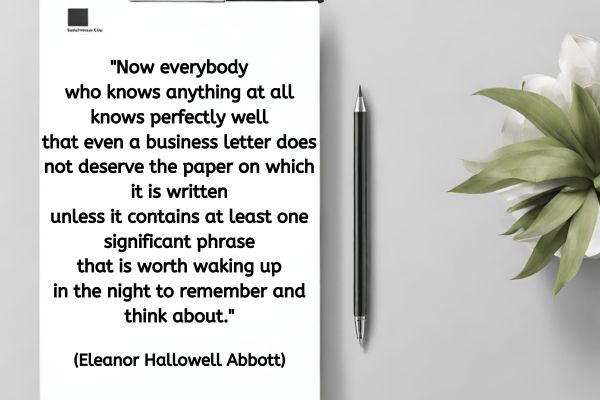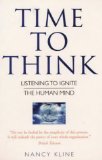Waking Up and Thinking About Truth

Happy Thursday! Today’s quote is:
“Now everybody who knows anything at all knows perfectly well that even a business letter does not deserve the paper on which it is written unless it contains at least one significant phrase that is worth waking up in the night to remember and think about.” (Eleanor Hallowell Abbott)
I pick these quotes for a variety of reasons, they jump out at me sometimes because I love the way something is worded and what it is pointing towards. Other times it may be because I agree with some of what’s said and there’s a part that feels slightly off and seems to be screaming to have a blog post written about it. Then there are the quotes that fall into the category of what do I need/want to hear about, the ones on an area I’ve been pondering about. There’s an element of that in today’s.
What makes a message something that is worth waking up and thinking about?
In the past I think if I’d been writing this I’d have talked around eloquent and eloquence language use, but then I’d have missed out on something before that.
Abbott’s insight challenges us to look beyond the surface of language and into the heart of communication itself. While eloquence certainly has its place, the true power of a message lies in its ability to resonate deeply with its recipient. It’s about more than just stringing together impressive words or phrases; it’s about conveying meaning, evoking emotion, and sparking thought. In essence, it’s about crafting messages that touch the soul and linger in the mind long after they’ve been received.
I think that there are two angles that are likely to prompt someone to wake up at night and think about your communication. The first is when the communication deliberately plays to and stirs up insecure and fearful thinking. It’s the sort that goes one step further than just describing a situation – it’s the sort of messaging that if it was a real life person would be that individual that likes to over dramatise, burning sausages becomes burning down the house etc.
Speaking from Truth
The second is when you speak from Truth.
For me, the first angle highlights the importance of ethical communication that uplifts and empowers rather than manipulates or instils fear. When messages deliberately play on insecurities or exaggerate situations for dramatic effect, they may grab attention momentarily but ultimately erode trust and authenticity. In contrast, speaking from Truth involves communicating with integrity, honesty, and compassion. It’s about sharing insights and perspectives that resonate with our deepest values and beliefs, fostering connection and understanding rather than division or fear.
I understand that this isn’t everyone’s perspective. I do think it explains why so many I speak to find the idea of marketing as “yuck”, they usually feel like it’s some sort of dirty thing that they need to do in order to do the thing that they love – coaching. They usually have a lot of thinking about how it should be done, and it feels like it’s a constant struggle to get the energy and motivation to do any communication that falls under the category of marketing or sales communication.
What if you can flip the script on traditional marketing and instead focus on authentically sharing your truth and value with others? What if marketing became an opportunity to connect deeply with your audience, to inspire and uplift them rather than manipulate or instil fear? By embracing Abbott’s insight and speaking from Truth, you can transform your communication into something that resonates on a profound level, leaving a lasting impact on those who receive it.
Imagine crafting messages that not only capture attention but also touch the hearts and minds of your audience, prompting them to reflect, engage, and take meaningful action. Instead of resorting to flashy tactics or empty promises, you can authentically share your passion, expertise, and vision with the world. This shift in perspective can turn marketing from a chore into a powerful tool for connection and transformation.
So, how do you speak from Truth in your communication? When you communicate from a place of authenticity and alignment with your core principles, your message naturally resonates with sincerity and integrity. I suspect that depending upon your own coaching approach, you may already know how to do that – maybe by getting clear on your values, beliefs, and the unique contribution you have to offer. Or just by getting really quiet and letting your own wisdom and creativity guide you. It will let you become a beacon of light in a sea of noise, drawing in those who resonate with your message and repelling those who don’t – and that’s okay.
Many years ago, I had a conversation with someone who didn’t go on to become a client. In fact, at one point during the call, I was seriously wondering if someone was pranking me. They said that they were having problems finding anyone who wanted to coach with them.
Upon questioning, it became obvious that they hated coaching, they didn’t like questioning people, in fact I suspect that in that moment they’d have broadened it to they didn’t really like people and couldn’t see any value in coaching. They really didn’t understand why anyone would voluntarily be a coaching client, let alone pay for it. When asked why they wanted to be a coach, they were honest and said it was because they thought it was an easy way to get money. If I had to guess, I’d say their potential clients were picking up on all of that and being repelled.
Moreover, speaking from Truth doesn’t mean you have to have all the answers or be perfect. It’s about being genuine, transparent, and vulnerable, acknowledging your humanity and inviting others to join you on the journey. When you approach communication with humility and openness, you create space for authentic connection and collaboration, fostering relationships built on trust and mutual respect.
I’m in the process of transitioning how I work to solely working as a Transformative coach, as opposed to any other type of coaching I’ve blended in the past. It’s been how my coaching has naturally evolved, and eventually it became evident to me that it was time to work completely in this form. Which means the way that I’m talking about my work is also transitioning to be a truer reflection of what I now do.
The way I’m doing that is to give myself permission that for a bit it won’t be as eloquent or diligent in my use of language as I try and find the way that is the best description of how I work now and what that is all about.
I’m guessing that if you’ve read this far, you could be in a similar situation and hoping for inspiration to strike. If so, I invite you to do two things:
i) to give your permission for this to seem clunky at first – don’t set yourself the expectation that it’s got to be perfect on the very first draft.
ii) let yourself get as quiet as you know how, and start by “fishing” for words that seem like they’re a fit. It may be that you think that the words that come up just seem really obvious and doesn’t that apply to everyone – without knowing the word then maybe, but in my experience what often happens is that words that come up that seem obvious are the ones that resonate must with how you work.
For example, nurturing is one that often came up for me. It’s always resonated and for me was an integral part of coaching – it took a mentor pointing out that not everyone coaches from that place that I came to recognise that for myself. And that can be modified and played with overtime – as I transition to completely being a transformational coach, what feels right as a description is impactful nurturing.
In conclusion, Eleanor Hallowell Abbott’s quote reminds us of the profound impact that meaningful communication can have on both the sender and the receiver. It challenges us to move beyond surface-level interactions and embrace the power of authentic expression. By speaking from Truth, we can transform our communication into a force for positive change, fostering connection, understanding, and empowerment. So, as you navigate your coaching journey, remember the importance of crafting messages that resonate with sincerity and integrity. Embrace your unique voice, share your passion, and invite others to join you on the journey toward growth, transformation, and fulfilment.
About Jen Waller

Jen Waller is on a mission to support, nurture and encourage coaching skills and talents from non-coach to coach and beyond.
As an experienced coach and trainer, Jen is happy to utilise all skills at her disposal to assist clients from getting out of their own way and making a difference in the world with their coaching. Find out more about the support Jen offers here.

 Anna-Marie is a Performance Coach with a serious passion for the outdoors who loves to head outside for walking and talking conversations with her clients. She is an accredited Analytic-Network (http://www.analyticnetwork.com) and mBraining (
Anna-Marie is a Performance Coach with a serious passion for the outdoors who loves to head outside for walking and talking conversations with her clients. She is an accredited Analytic-Network (http://www.analyticnetwork.com) and mBraining (
